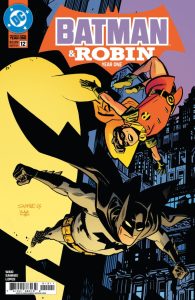This week: Daniel Warren Johnson’s Absolute Batman Annual 2025 #1 sees an alternate universe version of Batman brutalizing a horde of white supremacists as part of a larger contemplation of violence, hatred, anger, and more.
Note: the review below may contain spoilers. If you want a quick, spoiler-free buy/pass recommendation on the comics in question, check out the bottom of the article for our final verdict.
Absolute Batman Annual 2025 #1

Colorist: Mike Spicer, with Dave Stewart
Letterer: Clayton Cowles
This week’s Absolute Batman Annual 2025 #1 might be the angriest comic you read all year. Its lead story is about Absolute Batman encountering a mob of white supremacists who are brutalizing an encampment of immigrants — men, women, and children — and doing so violently, joined by masked members of a small town’s police force.
As Absolute Batman is wont to do, he responds by brutalizing the white supremacists, ten-fold. Destroying them and their organization, literally burning it to the ground. This untitled story is written and illustrated by superstar creator Daniel Warren Johnson, and you can almost feel his own anger (and eventually sadness) radiating from his work. There is, in particular, a two-page spread of Absolute Batman snapping a white supremacist’s arm that’s rendered in a visceral way and made to look dark.
A lesser story would stop, however, without adding that darkness. It would have Batman beat down the white supremacists in a way that played the whole thing as plainly heroic, as a superhero doing what needed to be done, probably without the detailed and extreme physicality. In this way, it might even come off as a sort of wish fulfilment, as Johnson and his collaborators (colorist Mike Spicer and letterer Clayton Cowles) having Batman do on page a thing that feels impossible and complicated in real life: physically stopping the punishment of the weak that we see in the news, being dealt daily on American streets. But this story pushes its narrative to a more conflicted place, and it is all the richer and more powerful for it, for layering in the nuance.
To accomplish this, there are two other key characters who appear in this story as well, both of whom side with Batman in wanting to help and to stop societal ills like white supremacy, but they also take other approaches outside of brutalization to do so.
The first is Thomas Wayne, Bruce Wayne’s father, who in DC’s Absolute Universe was a school teacher who was killed in a mass shooting, protecting his pupils. In a framing device for this tale, Thomas talks to Bruce of the innate desire to make the world a better place, describing his own choices to do so in a way that played to his skills and abilities as an individual — changing the lives of young people through education. More on his role later.
The other character who appears in this story is a man of faith, and a man who also wants to protect the migrant encampment, but he pushes back against Batman’s use of extreme violence, saying he does not know how to fix this problem but he does know what makes it worse. And I think this is where the complexity of the story’s emotional core really comes into focus for me as a reader. This is a story that is angry about more than one thing. It is, of course, angry about racism, human rights violations carried out either by or with the state, and aggression toward the vulnerable. But it also seems to be a story that is angry about what seeing such things does to all of us, and how it can inspire violence in those who want to help.
And I think that’s a really powerful narrative for our time. It’s a narrative with more questions than answers, questions around what justifies violent punishment, what is the cost of violent punishment, and what can we do to stop ourselves from being swept into violent cycles that erode our core values and make us lose ourselves. All without shying away from the extent of villainy being carried out.
That’s where the Thomas Wayne of it all comes back around. Although Batman is somewhat easily able to vanquish the white supremacists in this comic, he is left in a devastated place. He recalls his father telling him as a boy that he has “a strong and compassionate heart,” and that no matter what he does, he’ll always be proud of him. That last bit is juxtaposed over Batman cradling himself, in front of the giant machinery he just used to run over the mob’s headquarters, and it hurts. It hurts to see it, and that’s what makes this story great.
Phew. That’s a lot, and I’ve been reeling a bit since reading this comic, which I think is another sign that this lead story is a success. It’s also an audacious choice, in that I don’t think anyone involved with its telling is naive to how these kind of superhero driven explorations of complex and timely issues can be sanded down to talking points for keyboard warriors (who don’t read the actual comics) or segments on extreme ideological news channels. I’m sure the creators knew the lightning rod this story would become when its panels were taken in a vacuum without nuance, but they chose to tell it anyway.
Kudos to them for it. It’s also worth mentioning that on a comics craft level, this book is just unimpeachable. Johnson’s artwork is as kinetic and hard-hitting as ever, and his regular colorist, Spicer, once again brings it all to life perfectly, having fine-tuned his own contributions to Johnson’s lines. One creative choice that stood out here is Spicer boldly deploying solid colored backgrounds throughout to make both the action and emotions in play feel larger. Cowles is also arguably the best letterer in the game, no stranger to Batman or the font and lettering choices that make his world feel tough and lived in.
And while the lead story will generate all the conversation, it’s not even the only great tale in this book. There are two shorter stories as well, one by James Harren (who is colored by Dave Stewart and lettered again by Cowles), and that one also looks great, especially when it comes to using Absolute Batman’s caped tendrils. And, finally, there’s a nice chaser to it all by Meredith McClaren, for readers (like myself) who need a comedown.
Overall, the Absolute Batman Annual is an audacious comic. It feels like it started as an origin story for the character’s oversized Batmobile, and then it became a deeply personal and honest meditation on what’s happening in our world, the impulses it engenders, and the way it can make even the toughest among us feel broken. I highly recommend it.
Verdict: BUY
The Round-Up
It was an abbreviated, weird fifth Wednesday without a lot of releases, but if you’re looking for more traditional Batman comics, there are two other great ones. The first was the finale to Mark Waid and Chris Samnee’s fantastic Gotham City adventure story, Batman & Robin: Year One, on which the writer and artist are joined by colorist Matheus Lopes and letterer Cowles. This is such a great book. Waid and Samnee simply don’t make bad comics together, and Batman with a young, new Boy Wonder is a perfect fit for their sensibility. I loved it, and can’t wait to re-read it all together in trade.
- Finally, the other great Batman comic this week was Batman: The Long Halloween – The Last Halloween #10, which is the finale to a sequel series to the classic Jeph Loeb and Tim Sale story, The Long Halloween. With the great Tim Sale no longer with us, Loeb was joined on this book by (no exaggeration) 10 of the most interesting living artists who have worked in comics. What resulted was a book that was less driven by its plot (which, to be honest, I kind of stopped following) and more so by the beautiful Batman sequential art that rendered it all. This final issue saw Loeb joined by Matteo Scalera, who was colored by Stewart, and lettered by Richard Starkings and Tyler Smith. I had meant this week’s column to be a ranking to be an in-depth discussion of some of my favorite chapters in this series, but the Absolute Batman Annual scuttled those plans.
Miss any of our earlier reviews? Check out our full archive
And check out the Beat’s most recent comics reviews

 22 hours ago
3
22 hours ago
3








 English (US)
English (US)